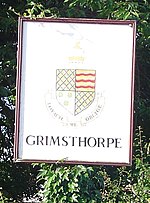Grimsthorpe Castle
Country houses in LincolnshireEnglish Baroque architectureGardens by Capability BrownGardens in LincolnshireGrade I listed buildings in Lincolnshire ... and 5 more
Historic house museums in LincolnshireJohn Vanbrugh buildingsParks and open spaces in LincolnshireUse British English from February 2023Woodland gardens

Grimsthorpe Castle is a country house in Lincolnshire, England 4 miles (6.4 km) north-west of Bourne on the A151. It lies within a 3,000 acre (12 km2) park of rolling pastures, lakes, and woodland landscaped by Capability Brown. While Grimsthorpe is not a castle in the strict sense of the word, its character is massive and martial – the towers and outlying pavilions recalling the bastions of a great fortress in classical dress. Grimsthorpe has been the home of the de Eresby family since 1516. The present owner is Jane Heathcote-Drummond-Willoughby, 28th Baroness Willoughby de Eresby, granddaughter of Nancy Astor, who died at Grimsthorpe in 1964.
Excerpt from the Wikipedia article Grimsthorpe Castle (License: CC BY-SA 3.0, Authors, Images).Grimsthorpe Castle
North Avenue, South Kesteven Edenham
Geographical coordinates (GPS) Address Nearby Places Show on map
Geographical coordinates (GPS)
| Latitude | Longitude |
|---|---|
| N 52.7923 ° | E -0.4523 ° |
Address
North Avenue
PE10 0LZ South Kesteven, Edenham
England, United Kingdom
Open on Google Maps








